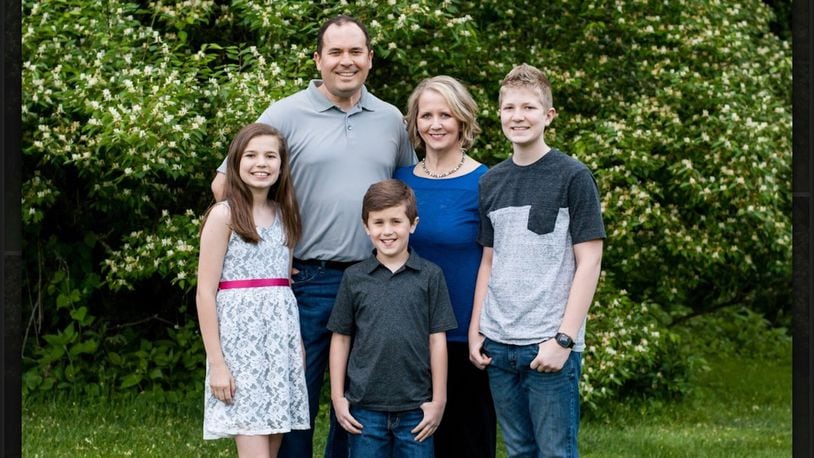Finally, in 2010 the mother of three found the answer she had been chasing for months. She was diagnosed by a connective tissue genetics doctor with Ehlers-Danlos Syndrome-3. The Ehlers-Danlos syndromes, or EDS, are a collection of 13 multisystemic, heritable disorders affecting the connective tissues in the body.
Patients with EDS are often referred to as zebras, which references the medical school mantra, “when you hear hoof beats, think horses, not zebras,” equating zebras with rare diseases.
McKain began a local support group in 2010 to aid others that are new to their EDS journey. May 1 was the beginning of a monthlong observance of awareness, education, outreach and fundraising for EDS.
The Today’s Pulse found out more from McKain:
Q: What is Ehlers-Danlos syndromes (EDS)?
A: EDS is a group of connective tissue disorders that are inherited and vary both in how they affect the body and in their genetic causes. They are generally characterized by joint hypermobility, skin hyper-extensibility and tissue fragility. There are several subtypes of EDS, each with a set of clinical criteria.
Symptoms are unique to each person; however, some common threads may include: joint hypermobility, loose unstable joints prone to dislocations and subluxations; joint pain, onset of osteoarthritis; musculoskeletal pain and fatigue; soft velvety skin that can be stretched easily, easy bruising, severe scarring and slow wound healing.
EDS is commonly misdiagnosed as fibromyalgia and chronic fatigue syndrome.
It is called an invisible illness, because we simply don’t look sick. Many EDSers have no outward signs of the syndrome, yet so much is going on inside with their connective tissues.
Q: How has EDS impacted your life?
A: When I was first diagnosed, I consulted with a spine surgeon, who recommended fusing C1C2 vertebrae together to stop the vertigo, saying my C1C2 was slipping and cutting off the blood supply to my brain. I had the surgery in 2010. I was in a hard C collar brace for 12 weeks and took almost a full year to heal. I then had lower lumbar fusion at L4L5 with a disc replacement in 2011. My left foot arch had fallen, so walking like this for years caused disc deterioration.
The lumbar fusion was a success. The C1C2 fusion was not. The hardware broke inside my neck, causing issues until I was able to have it corrected by a neurosurgeon out of state who specializes in patients with EDS. I ended up having three spine surgeries in five years. (Note: McKain initially was treated by Dr. Abubakar Atiq Durrani, the Mason spine surgeon who fled the country after numerous lawsuits and federal charges alleging he performed unnecessary and botched surgeries.)
I am also treated for Postural Orthostatic Tachycardia Syndrome and TMJ and wear orthotic inserts in my shoes. These are common for people with EDS.
Q: What has this meant for your life?
A: After getting through those rough years of surgeries and long recoveries, I have been able to proceed with my life as wife and mother to my three amazing kids.
Some days, I lead a pretty normal life — volunteer at church, school and in the community. Other days, I am not so lucky: The fatigue and pain can get the best of me. I usually manage this with rest and over-the-counter pain relievers.
I wake up each day popping joints and bones back where they belong and then go about my day as best I can, resting when needed. Some days I can clean my home and do other common tasks; other days, I feel pain and dizziness from doing so. I have learned to pace myself.
I try to stay upbeat and positive as I know it could be worse. I have a strong faith, and I know God has gone before me in all of this and he can see the whole picture.
Q: Why is it important to raise awareness of EDS?
A: Many EDS patients are told it is all in their heads: They don't look sick, their reports come back normal or they're told to go see a psychiatrist.
It takes a lot of time and a little luck to get to the right doctors. It is considered a rare illness and not many doctors are familiar with EDS.
EDS effects are minimal in some people, while others are in wheelchairs or in and out of the hospital countless times a year. I know some EDS friends who suffer greatly. EDS can affect anything that is made of connective tissue, and that’s a lot of your body. Awareness is key for education, research and, hopefully, a cure.
For more information, email cincyzebras@gmail.com.
Contact this contributing writer at lisa.knodel@gmail.com.
About the Author
